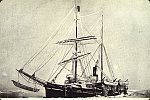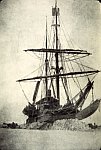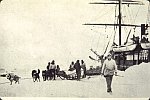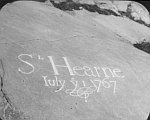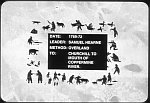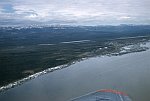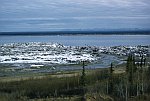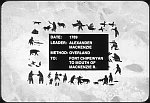Explorers and Northern Exploration
Author: Anne Mease Page 1 | Page 2 | Page 3
Roald Amundsen (1872-1928)
After hundreds of years, numerous voyages, and many deaths in search of the Northwest Passage, Norwegian born, Roald Amundsen was the first to successfully 'find' the Northwest Passage in 1906. He quit medical school to become an explorer upon learning about Franklin's expedition. In fact, he would become one of the greatest explorers of all times and would be the first to discover the North Pole, the South Pole, and the Northwest Passage and the first person to fly over the Arctic and the first person to die while flying over the Arctic.
He took part in his first expedition as third command with the Belgian Antarctic expedition in 1897. They were in search of the South Magnetic Pole. Their ship became stuck before they reached their destination and they were stranded for thirteen months. They returned to Norway after what Amundsen deemed to be an " unsuccessful but ...inglorious cruise."[40]
Like so many explorers before him he was obsessed by the literature that told of many attempts to find the Northwest Passage but more feverously, at that moment in time, the race was on to be the first to reach the North Pole.
He speculated that the Northwest Passage "would have been achieved by Sir John Franklin had he, on approaching Cape Felix, made a detour to the east of King William Island instead of plunging into the heavy ice which lay to the west."[41]Additionally, based on Sir James Ross' location of the Magnetic North Pole in 1931, he theorized that the Northwest Passage could be a crossed if the above directions were taken.
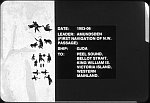
Slide showing Amundsen first voyage to Peel Island, Bellot Straight, King William Island, Victoria Island, Western Mainland.
He procured financial backing to purchase the Gjoa and set sail on June 16, 1903 from Christiana Harbour for his second expedition in search of the Northwest Passage.
Amundsen ensured they had enough food and gas supplies to last 'five years,' He sailed past Siberia, Greenland, Baffin Bay, Lancaster Sound, across Barrow Strait into Peel Sound until they could go no further due to ice at Gjoahaven.
In 1904, Amundsen set out to find Ross' magnetic North Pole, only to find it had moved 'thirty miles.' In doing so he became the first to re-discover the magnetic North Pole. The accomplishment for Amundsen is that it became a known fact that the Pole 'moved.'
They chose to that location as the place where they would spend two winters searching for and discovering any geological landscape that would indicate a route that would connect the Northwest Passage. On their journey inland they came into contact with the local inhabitants who they cautiously befriended after a hesitant exchange of greetings (Man-il-tu-mi). Amundsen hired the Inuit women to make them winter clothes and the men to provide provisions. They built a relationship upon reciprocity that Amundsen contributed to the success of the expedition for they could not have survived without their assistance and direction.
Amundsen found the Northwest Passage "on August 17, they anchored inside the entrance to Cambridge Bay...the entire Northwest Passage had been navigated in halves, by the Englishmen from the west and the Norwegian from the east. It remained for Gjoa to knit the two together in one continuous voyage." [42]
The Gjoa was finally free from the ice by August of 1905. Amundsen and his crew headed towards Both Point, through Dease Strait to King's Point where they were grounded by a previous shipwreck of the Bonanza. There they unexpectedly wintered but made the best of being stranded. Amundsen headed overland towards Herschel Island where met with the Captain of the Bonanza and they headed by sledge along Porcupine River in the Yukon into Eagle, Alaska. He had sent off a telegram months earlier telling the world of his spectacular find, only to find his telegram did not reach any further than Eagle.
With the Northwest Passage conquered, Amundsen set out to be the first to reach the North Pole. However, upon hearing news that Robert Peary had reached the geographical North Pole on April 6, 1909, he changed his course of direction and unbeknownst to his financial backers, he endeavored to be the first to reach the South Pole. Another explorer by the name of Robert Scott was also thinking the same thing and the race was on again for Amundsen.
Equipped with food and gas supplies snowshoes, kayaks, and sledges, Amundsen journeyed across the unknown ice mass of the Antarctica towards the South Pole. Scott on the other hand, was equipped with snow machines and other motorized equipment that Amundsen knew from experience would not survive the harsh Arctic environment or terrain. He was right, ninety-nine days later on December 14, 1911, Amundsen and his four companions - Hansse, Hassel, Bjaaland and Wisting placed the Norwegian flag into the snow claiming the South Pole in the Antarctica as belonging to Norway by right of discovery.
Amundsen like many other explorers would lose his life to the Artic but unlike others who lost their lives to the fierce rugged ocean or to the vast frozen land, he lost his life when the 'dirigible' he was flying crashed over the North Pole in 1926. Like other explorers he was on a search mission looking for Italian explorer Umberto Nobile, whose aircraft was also missing.
Vilhjalmur Stefansson (1879-1962)
Vilhjalmur Stefansson, was born to Icelandic parents in Manitoba, Canada in 1879. His family moved to North Dakota when he was a young child where he eventually attended University. His Arctic exploration was not in search of the Northwest Passage or the North Pole but rather to 'discover' the economic resources that lay in the Arctic. Stefansson, a trained anthropologist, soon turned his interests towards ethnology and studying Inuit culture, namely, their diet.
Stefansson experienced his first Arctic exploration in 1906-07 when he traveled to Herschel Island with Danish explorer Ejnar Mikkelson. It was on this expedition that Stefansson became interested in the inhabitants of the Canadian Arctic. The Copper Inuit that he came into contact with had blue eyes and he theorized they were the descendants of either the Norse, who had visited hundreds of years earlier or members of Franklin's crew.
In 1908, Stefansson, sponsored by American Museum of Natural History and the Geological Survey of Canada explored the Arctic with a zoologist by the name of Rudolph M. Anderson. Anderson was in search of zoological artifacts and Stefansson was in search of the blond-haired, blue-eyed Inuit on Victoria Island. They traveled by sledge to Herschel Island, Cape Parry to the south side of Victoria Island.
Stefansson fully immersed himself into Inuit culture by living amongst the Inuit for four years. He learned their language and consequently was one of the first Anthropologists to take an emic or insider's approach to studying culture. He became such a part of their culture that he fathered a son with an Inuit woman known as Pannigabluk in 1910.
The expedition returned home to the United States in 1912. They had successfully proven that there was still unexplored research in the animals, culture, and the land that needed to be done but more importantly, the results of the expedition gained Stefansson a reputation as an experienced and admirable explorer whether on sea or land.
Over a span of five years "[b] etween 1913 and 1918 the federal government funded [a] Canadian Arctic Expedition, co-led by Canadian explorer Vilhjalmur Stefansson." [43]
In July 1913 they sailed out of Nome, Alaska on a ship named the Karluk. Aboard the Karluk was a crew of twenty-five including Stefansson, a math teacher by the name of William McKinlay, Diamond Jenness (anthropologist), Dr. Anderson (zoologist), James Murray (oceanographer), and an assortment of experienced scientists and sailors who were un-experienced about the North.
The Karluk met its demise one month later near the end of August when it became lodged in ice between Barrow, Alaska and Herschel Islands. Everybody escaped the ship and it was one year before they were rescued. In that time they were taken care of by the Inuit and but they still lost eleven crewmembers who perished from starvation, illness, and suicide. Meanwhile, Stefansson and a small entourage parted company after they abandoned ship and trekked mainland in search of food. When they returned to the location of the ship, it had drifted off. Stefansson was stranded and apparently they drifted on ice floes from location to location.
Stefansson can be credited as one of the first explorers to take an acute interest in the people through his well-documented ethnologies. Though he has been accused of carrying out his endeavor for notoriety, which he did receive, he gained more satisfaction in knowing that a European could co-exist with the Inuit. He is considered one of the three world's greatest explorers, next to Amundsen and Peary, also Norwegians.
Additionally, "Stefansson and his Northern Party not only discovered four new islands which were added to Canada's territory, but also discovered and re-mapped significant errors in the maps previously available, some of which were based on British Expeditions of the 1850s that were part of the search for Sir John Franklin."[44]
Stefansson never did return to the Arctic and spent his final days as a lecturer and author after being discredited for carelessly identifying the hundreds of vital artifacts he had collected. He died in 1962 in New Hampshire.
Discovery in the Sub-Artic
Samuel Hearne (1745 - 1792)
Samuel Hearne joined the Hudson's Bay Company in 1766. He sailed to Canada on the Churchill. While the frenzy was on to find the Northwest Passage, there was also another frenzy beginning mainland with the 'discovery' of copper by the Dene (Chipewyan) near what would be Coppermine River, NWT. Until this point, the Hudson's Bay Company was reluctant to move their Forts any further than the shores of the water. Hearne set out from Fort Prince of Wales in 1968 to begin his Northern expedition by foot (snowshoe) and canoe. The entourage consistent of Samuel Hearne and two Aboriginal guides. They only made it about two hundred miles inland towards the Arctic coast before turning around and heading back to the Fort in December of the same year.
In February 1769, Hearne set out on his second journey. He took along with him three Chipewyans (Dene) and two Home-guard Cree. Hearne noted at the beginning of their journey that the wildlife for provisions was plentiful and everyone was well-fed but between March and May they came close to starvation on more than one occasion. While on Hearne's return to Fort Prince of Wales he met a Chipewyan Chief by the name Matonabbee who offered to be his guide. Hearne's accepted cautiously.
Matonabbee proved to be a loyal and trusted companion and confident friend of Hearne's. They traveled first by snowshoe to Partridge Lake, Thewholekyed Whoie, or Snow-bird Lake and Clowey Lake before arriving at their final destination in Coppermine River on July 14, 1770. Hearne ventured 'eight miles' towards the Arctic coast where, as the first European to reach the Arctic from inland, claimed the territory on behalf of the Hudson's Bay Company.
Along the way, approximately 70 Dene joined the expedition and unbeknownst to Hearne's, they were waiting to meet and battle with their fiercest enemies, the Copper Inuit who were just across the river. The attack and massacre upon the Inuit happened on July 17, 1771. Hearne's called the location 'Bloody Falls.' On their return journey back to Prince of Wales Hearne's is credited for ' discovering' Great Slave Lake in Alberta.
In June of 1774, Hearne's established the first inland trading post for the Hudson's Bay Company at Cumberland House, Saskatchewan.
Sir Alexander Mackenzie (1764-1820)
Sir Alexander Mackenzie, one of Canada's earliest inland explorers and fur traders, was born in Scotland. He began his exploration career when he became a partner in North West Company. He was sent to operate Fort Chipewyan on Lake Athabasca in 1789. As with explorers of the day, finding the Northwest Passage was not far from the back of Mackenzie's mind when he 'discovered' the Mackenzie River while looking for a route that would lead to the Pacific Ocean.
In 1793, Mackenzie traveled west through Peace River (Alberta), across the Continental Divide, 'discovered' the Fraser River (British Columbia) and into Bella Coola, where the Pacific Ocean lay. He is the first person to cross the Continental Divide and the first to cross overland to the Pacific Ocean.
For his accomplishments as a sub-Arctic explorer, Sir Alexander Mackenzie was highly recognized by Canada for his achievements in being awarded a knighthood in 1802 and election to the Legislative Assembly of Lower Canada in 1805. The exploration overland to the west would be Mackenzie's final journey and little is known about him after that except that he returned to Scotland to live out his final days.
Conclusion
Hundreds of lives and dreams were lost as the early explorers set out in less than adequate ships with less than reliable navigational equipment in search of the Northwest Passage. In the process, the Canadian Arctic and all its islands, bays, fiords, mountains, valleys, rivers, creeks, and streams were 'discovered' and named for those or by those who 'discovered' any given area. The Northwest Passage was approached from the east and west and was not ' conquered' until the1800s. Voyages were financed by Mother countries in the hope that their men would be the first to find the route to riches. Private financers often went broke while supporting Arctic expeditions. Once the Northwest Passage was passable, the shift turned towards finding the magnetic North and South Poles. Once accomplished, the only thing left to 'discover' were the original inhabitants who had survived where others could not.
Prior to Stefansson's interest in Inuit culture, the relationship between European and Inuit were not receptive encounters or ones built on mutual agreement and understanding. In most instances, misunderstanding caused by language and cultural barriers occurred which was generally followed by violence. The European's who had guns as opposed to stone and bone tools inevitably had the advantage in any battle that ensued but in most other cases, they did not have the manpower to overtake the Inuit and their attempts to anchor sail would be abandoned. In many other instances the Inuit, as well as other Aboriginal people in Canada were kidnapped and returned to the Mother Country as objects to be exhibited.
Endnotes
[40] L.H. Neatby. Conquest of the Last Frontier. Ohio University, 1966:296
[41] Ibid: 297
[42] Ibid: 312
[43] Donald Purich, Inuit and Their Land: The Story of Nunavut. James Lorimer & Company, Toronto. 1992:32
[44] Canadian Arctic Expedition - Mapping <http://www.civilization.ca/hist/cae/map12e.html>



